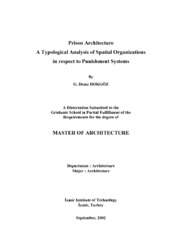Please use this identifier to cite or link to this item:
https://hdl.handle.net/11147/3725Full metadata record
| DC Field | Value | Language |
|---|---|---|
| dc.contributor.advisor | Eyüce, Özen | en |
| dc.contributor.author | Dokgöz, G. Deniz | - |
| dc.date.accessioned | 2014-07-22T13:52:13Z | - |
| dc.date.available | 2014-07-22T13:52:13Z | - |
| dc.date.issued | 2002 | en |
| dc.identifier.uri | http://hdl.handle.net/11147/3725 | - |
| dc.description | Thesis (Master)--İzmir Institute of Technology, Architecture, İzmir, 2002 | en |
| dc.description | Includes bibliographical references (leaves: 113--118) | en |
| dc.description | Text in English; Abstract: Turkish and English | en |
| dc.description | xii, 119 leaves | en |
| dc.description.abstract | The concepts of crime and punishment have always been a part of culture in every society throughout the history of mankind. However, the acts accepted as .crime. and the penalties imposed upon criminals for the same crime have revealed differences in each society and in each era. Prior to the Modern Age, almost in all societies, punishment was an open public activity to warn people and imprisonment was not a way of punishment; instead it was only a measure impeding the criminal.s escape until the execution of punishment. Modern world, at the beginning, has tried to use punishment for dictating definite .norms. instead of frightening; later on, instead of corporal execution some other punishment systems have been used as a means of creating individuals submitting to the authority on the way to the formation of inspection oriented .New Society.. This new approaches in punishment systems has required spatial and organizational solutions. As a result, prisons in which imprisonment would be executed have developed as a new building type requiring architectural design as other new building types developed during modernization. However, prison architecture is different from all other buildings as an architectural end product. This architectural product is such a place that whoever stays in never wants to live in there and wants to get out it as soon as possible since there is no relation between the spatial properties of the building and the preferences of a person staying in it, in other words, the criminal. Although debate on prison buildings seems to be a current issue in public opinion, discussions on the spatial organizations of prisons. coincides with the of F-type applications of Ministry of Justice in Turkey. On the other hand, the problems of this building type haven.t been examined enough in terms of architectural design approaches. It is important to discuss how prisons. spatial design have been developed throughout the history; and which architectural properties a prison has to have today must be considered. Whether a prison system, in which the person serving his/her sentence will not be damaged both physically and mentally by public authority, environment and other criminals during its detention period, is created or not, or relevance of the created spaces to the prevailing understanding of punishment and their appropriateness to its functions should also be studied. Therefore, this study aims at understanding prison architecture., their development and change in relation to changing social structures. A typological analysis on case studies is used to understand their spatial organizations in a retrospective perspective. Key words: Crime, Punishment, Prison, Prison Architecture, Type, and Typology. | en |
| dc.language.iso | en | en_US |
| dc.publisher | Izmir Institute of Technology | en |
| dc.rights | info:eu-repo/semantics/openAccess | en_US |
| dc.subject.lcc | HV8805. D65 2002 | en |
| dc.subject.lcsh | Prisons--Design and construction | en |
| dc.subject.lcsh | Crime | en |
| dc.subject.lcsh | Punishment | en |
| dc.title | Prison architecture a typological analysis of spatial organizations in respect to punishment systems | en_US |
| dc.type | Master Thesis | en_US |
| dc.institutionauthor | Dokgöz, G. Deniz | - |
| dc.department | Thesis (Master)--İzmir Institute of Technology, Architecture | en_US |
| dc.relation.publicationcategory | Tez | en_US |
| item.openairecristype | http://purl.org/coar/resource_type/c_18cf | - |
| item.grantfulltext | open | - |
| item.cerifentitytype | Publications | - |
| item.fulltext | With Fulltext | - |
| item.openairetype | Master Thesis | - |
| item.languageiso639-1 | en | - |
| Appears in Collections: | Master Degree / Yüksek Lisans Tezleri Sürdürülebilir Yeşil Kampüs Koleksiyonu / Sustainable Green Campus Collection | |
Files in This Item:
| File | Description | Size | Format | |
|---|---|---|---|---|
| T000566.pdf | MasterThesis | 6.4 MB | Adobe PDF |  View/Open |
CORE Recommender
Page view(s)
554
checked on Nov 18, 2024
Download(s)
356
checked on Nov 18, 2024
Google ScholarTM
Check
Items in GCRIS Repository are protected by copyright, with all rights reserved, unless otherwise indicated.